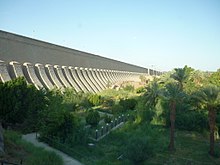| Aswan Low Dam | |
|---|---|
 Aswan Low Dam | |
| Official name | Aswan Low Dam |
| Location | Egypt |
| Coordinates | 24°02′02″N 32°51′57″E / 24.03389°N 32.86583°E |
| Construction began | 1899 |
| Opening date | 1902 |
| Owner(s) | Egypt |
| Operator(s) | Egypt |
| Dam and spillways | |
| Type of dam | Gravity, masonry buttress |
| Impounds | River Nile |
| Height | 36 m (118 ft) |
| Length | 1,950 m (6,400 ft) |
| Spillway type | Floodgates |
| Reservoir | |
| Creates | tailwater of Lake Nasser |
| Total capacity | 5,300×106 m3 (4,300,000 acre⋅ft) |
| Power Station | |
| Commission date | Aswan I: 1960 Aswan II: 1980–85 |
| Turbines | Aswan I: 7 × 40 MW (54,000 hp) Kaplan-type Aswan II: 4 × 67.5 MW (90,500 hp) Kaplan-type |
| Installed capacity | 592 MW (794,000 hp) (Aswan I, II) |
The Aswan Low Dam or Old Aswan Dam is a gravity masonry buttress dam on the Nile River in Aswan, Egypt. The dam was built by the British at the former first cataract of the Nile, and is located about 1000 km up-river and 690 km (direct distance) south-southeast of Cairo. When initially constructed between 1899 and 1902, nothing of its scale had ever been attempted; on completion, it was the largest masonry dam in the world. The dam was designed to provide storage of annual floodwater and augment dry season flows to support greater irrigation development[1] and population growth in the lower Nile. The dam, originally limited in height by conservation concerns, worked as designed, but provided inadequate storage capacity for planned development and was raised twice: between 1907 and 1912 and again between 1929 and 1933. These heightenings still did not meet irrigation demands and in 1946 it was nearly over-topped in an effort to maximize pool elevation. This led to the investigation and construction of the Aswan High Dam 6 kilometres (3.7 mi) upstream.[2]
- ^ Power from the Assuan Dam to Be Used to Increase Still Further the Cotton Crop in Egypt, The New York Times, July 27, 1913, (pdf file)
- ^ "The First Aswan Dam". University of Michigan. Archived from the original on 15 June 1997. Retrieved 2 January 2011.